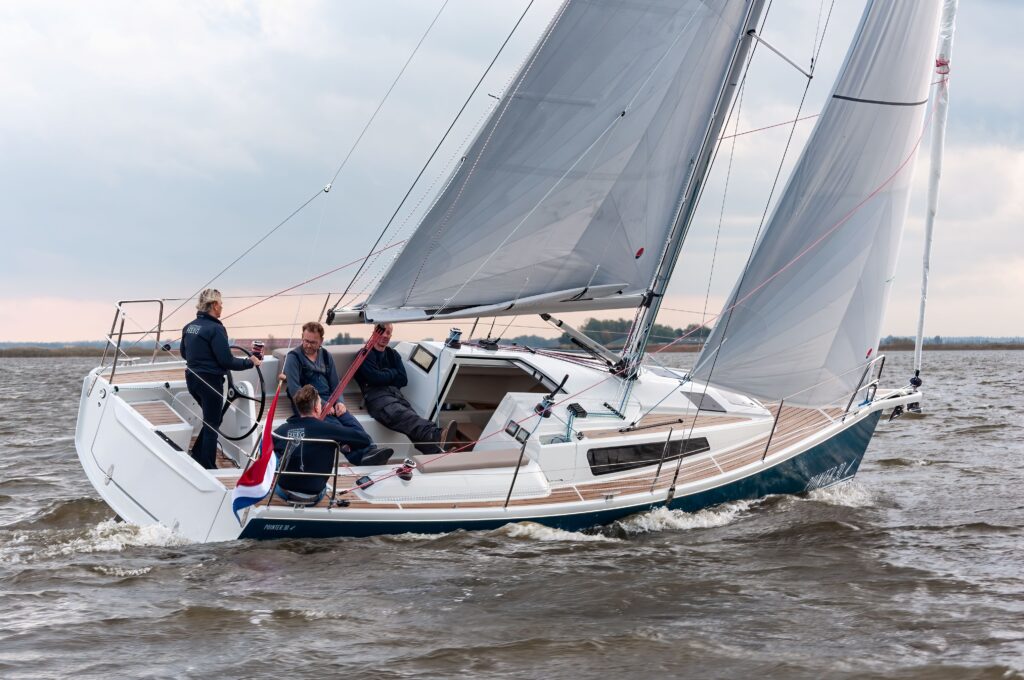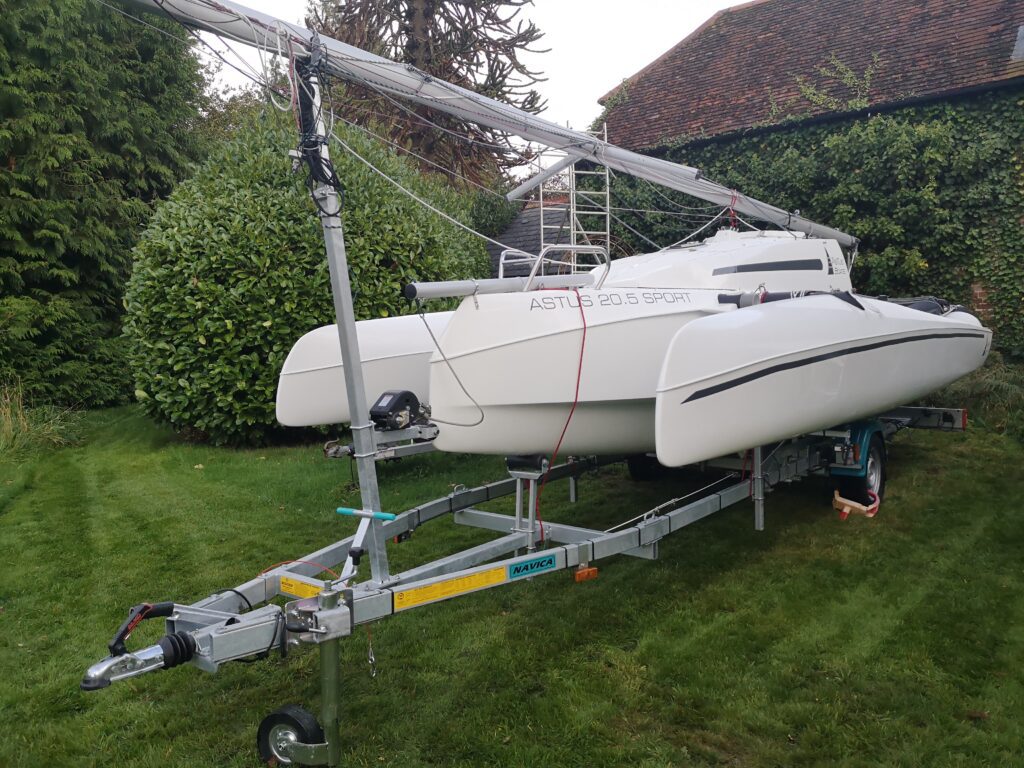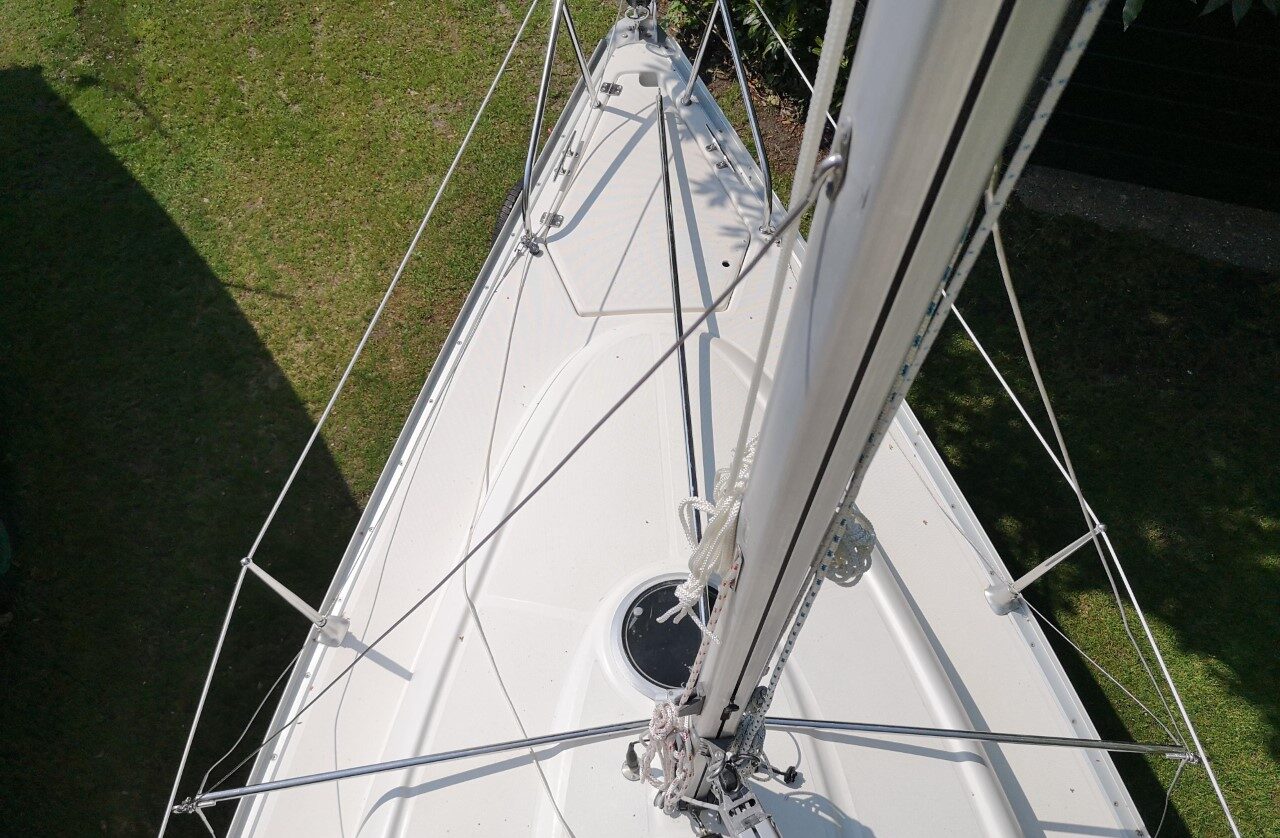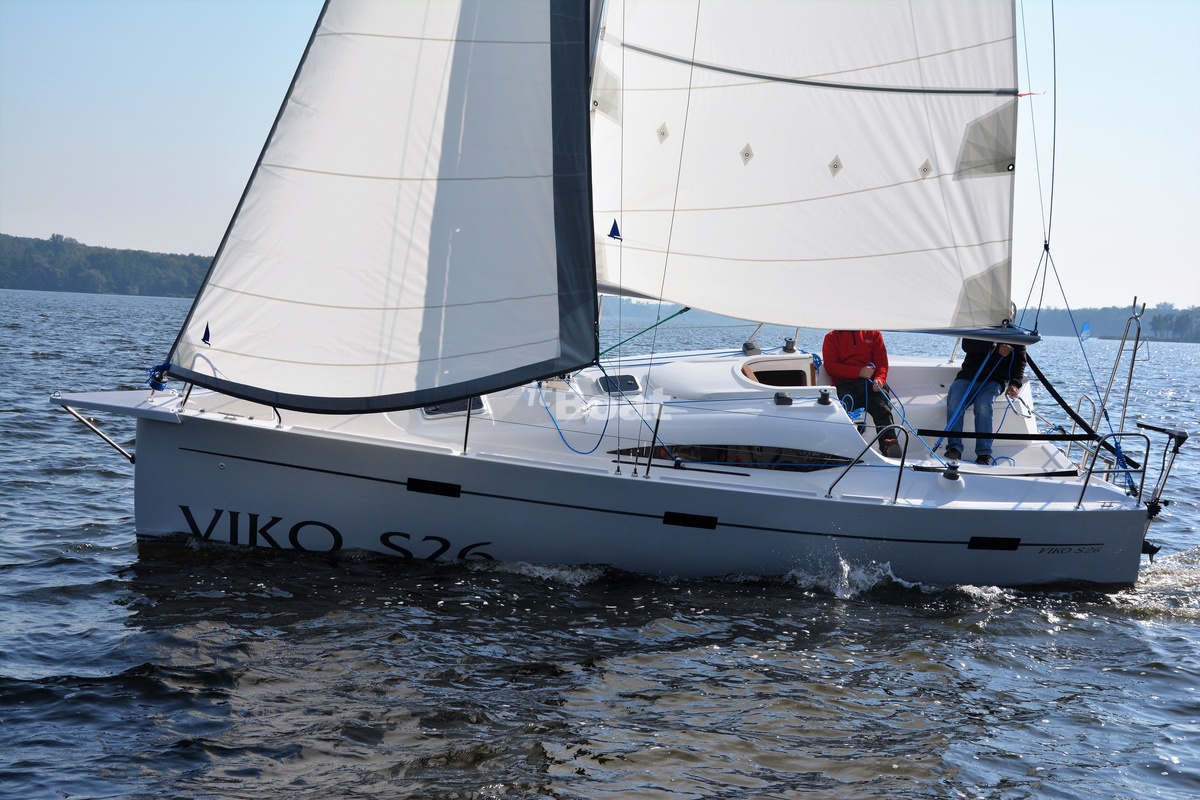Is It Trailable?
At Boats on Wheels we're often asked 'would this boat be easy to trailer sail?' We then invariably have a discussion about the boat's characteristics and suitability for launching, recovering and towing using a trailer. We then arrive at the conclusion that either it is a 'trailer sailer' or its just basically a small yacht which could be trailered with varying degrees of difficulty. This article aims to help people who want to get into trailer sailing and want help in deciding which small yachts might qualify. We won't go into the 'obviously easy' group of trailer sailers, like dinghies or small open keel boats, but focus on those small yachts, 19 foot or more, which might be more on the margins of the trailer sailer category. We will also limit ourselves to the more popular ranges of European models which have been in production for the last 30 years or so.
So, what are the attributes that differentiate genuine trailer sailers from small yachts?
1. Shallow draught is king
The key to easy launching and recovery of a trailer sailer is its draught. Most of these small yachts come with lifting keels so that they can be floated onto a partially submerged trailer with the wheels of the towing vehicle remaining largely dry on the slipway. This is particularly important on coastal waters where the corrosive effects of salt water would have a significant impact on car brakes, bearings and other metal parts. To be counted as true 'trailer sailers' most boats in this category float in around 8" to 18" of water - the Parker 21 and 235 are good examples of this trait. This means that the lifting keels or centreboards need to fully or mostly retract into the hull of the boat. Shallower fixed bilge keels offer an alternative possibility, although often at the expense of sailing performance. Separate launching trolleys such as those often seen under dinghies and Cornish Shrimpers offer another means to keeping a car and a road trailer well out of the water. Yet there are some larger yachts which still do the job of launch and recovery in shallow water rather well even without launching trolleys. Take the Sedna 26 and the water ballasted Dehler 25 - both float in only 40cm of water or less.
When boats have a deeper draught, say over 50cm, then, depending on the gradient of the slipway, it becomes almost impossible to keep your car axles dry without the use of a long strop or tow bar extension. One of the most popular 'trailer sailers' around, the Beneteau 21 foot series, for example, need 70cm of water under them to float due to their stub keel which is mounted under, not in, the hull even when retracted. If you don't mind submerging your trailer or having your yacht hoisted in then other shallow draught boats to consider may be then the Etap 21i, with its 70cm deep tandem keel or the wing keeled MG Spring 25 (91cm) might fit the bill. Similarly, the more contemporary Pointer 25 and Pointer 30 - designed for shallow Dutch waters they draw only 1.1m and 1.25m respectively. If you're planning on recovering any of these fixed keel yachts onto a trailer then we would certainly recommend a set of guide posts so that you can see where the submerged trailer is as you float your boat on.
The Jeanneau Sun 2000 – popular for it’s shallow draught…

2. Beamy boats make towing harder
British roads have a maximum permissible trailer width of 2.55m (8'4"). Its a commonly held misconception that a boat must therefore also be under 2.55m wide for it to be legally permissible on our roads. Indeed many popular trailer sailers are around 2.5m wide - so, the widely quoted Jeanneau Sun 2000 has a beam of exactly 2.55m. In fact, a boat is described in the towing regulations as a 'load' which has a separate maximum width in the roads of 2.9m. (Above 2.9m a boat would be described as a 'wide load' and you would need to make special arrangements.) So, if you're after more space and headroom you can technically tow beamy boats such as the MG Spring 25 (2.75m wide) as well as contemporary boats like the Sedna 26 (2.85m), the Viko S26 (2.80m) and the Jeanneau Sun 2500 (2.9m). If that isn't enough for you, both the Ron Holland Parker 275 (2.8m) and even the more modern Pointer 30 (2.9m) can be legally towed on British roads.
The real question is not what is technically permitted but whether a 25 foot+ boat can be easily towed behind a normal car. Most big 4x4 cars are a little under 2m wide. Most caravans are only 2.55m wide. So, you're towing a load which is 3 feet wider than most cars and a foot wider than all caravans. Picture yourself doing that on a Cornish B-road! Realistically, yachts well above 2.5m wide may well spend their winters on a trailer but would typically be moved only a handful of times per year on familiar roads, probably not for a short weekend outing.
Even certain larger yachts are trailable

3. Lighter is Better
Quite a few budding trailer sailors underestimate the towing requirements of specific boats and their trailers. A typical popular 21-22 footer weights well over a tonne - the two examples mentioned already, the Jeanneau Sun 2000 and Beneteau 21 footer series weigh in at around 1.25t. Once you add a 450kg trailer and a bit of boat inventory, fuel and water you can quickly top 1.8t. You would need a large family car like an Audi A6 or a Ford Galaxy to tow a boat like that. The massive recent growth in 4x4 SUVs has certainly made heavier boats more accessible for trailer sailing but unless you own one of the meatier models with a 3t+ towing capacity, the car you drive may well determine what boat you can legally take on the road. (Indeed, if you obtained your driving licence after January 1997 you face more restrictions in the total weight you can tow - check the rules here.) The beamier group of trailerable boats mentioned previously are therefore out of the towing range of most cars. The Sedna 26, the MG Spring 25 and the lift keel Beneteau 25.7 are all 2t+ yachts, nearer 3t once you've added a meaty double axle trailer and inventory. If you're after a 25 footer, there is some variation in the range: whilst the Jeanneau Sun 2500 weighs in at over 2.2t, the Pointer 25 mentioned before weighs only 1.5t. If you don't mind sacrificing sailing charactaristics for space and headroom the Viko S26, comes out somewhat better with two keel versions both claimed to be under 2t (1650kg & 1800kg). Realistically most of these boats require an SUV to tow them.
For boats to be counted as true trailer sailers which don't require a radical change of car they really need to weigh in at around a tonne or less. If the boats in current production Swallow Yachts manage this well with their water ballast system - their Baycruiser 21 weighs only 600kg and the 23 weighs in at only 850kg! Not everyone is a fan of water ballasted boats or their limited accomodation but there is no denying the Baycruiser 23's trailability. The other way of reducing weight is through the use of advanced production techniques like resin infusion. The racy Beneteau First 24 does this well too by weighing in at only 985kg but with a whopping price tag. Buckley Yacht Design's has produced a light weight gem, the BTC-22, which displaces only 940kg at a more affordable price.
A different approach to creating small light weight yachts is to dispense with ballast all together. Trailerable trimarans like the Astus 20.5 and 22.5 rely on their stability from their float buoyancy and width when sailing. With the floats retracted however they can be towed behind ordinary family cars - the 20.5 weighs in at around half a tonne and the bigger 22.5 displaces only 650kgs! This makes the trimarans the class leaders when it comes to towing weight.
Trimarans don’t need ballast – The Astus 20.5 weights only 500kg

4. Don't forget rigging effort
One of the biggest contraints to easy launch and recovery of a trailer yacht is how simple it is to get the rigging up, especially when short-handed. Some trailer sailers are inherently easy to rig. Gaff rigged boats like a Cape Cutter 19 or Cornish Shrimper 19 have tall mast tabernacles on the coach roof and relatively short wooden masts which can be raised single handed at a push. Swallow Yachts also do well with their light carbon rigs and cassette based boom/lazyjack systems. Yet for more common mast-top or fractional aluminium rigs the mast lifting challenge becomes more daunting the bigger the boat. The problem lies in leverage - the longer and heavier the mast, the harder it is to push up and control when you can only hold the bottom section, and the more damaging it can be if control is lost. Lateral movement can easily rip out the mast base or damage the coachroof and mast hardware.
Even medium sized 'trailer sailers' like the Beneteau 21 footers mentioned before usually require at least 2 crew members, ideally 3 or 4 to get a mast up. As for the bigger boats, one dreads to think. This is why mast stepping causes more stress in trailer sailing owners than almost anything else. So the options for masts are: to go for a small and light boat, to enlist the help of volunteers, to hire a crane or to use some of the ingenious mast lifting systems which manufacturers have dreamt up. As trailer sailors are a self reliant bunch the volunteer option is not favoured and the idea of using a crane would be an affront to true trailer sailors everywhere. So, to add any medium sized or bigger trailable yacht to the trailer sailer category it requires a pretty nifty mast lifting arrangement to make the the mast raising process safe and 'effortless'. To get a horizontal mast up requires the application of upward force so, usually this is done with means of a gin pole or A-frame which sits at a 90 degree angle to the mast and, on a 21 footer is about 6-8 feet up. A block and tackle or winching system then provides the pulling power. Another critical element of a lifting kit is the control is required to avoid deck chomping lateral movement of the mast. Manufacturers usually add cables to either the sides of the mast or the gin pole or both to ensure that the mast goes straight up (an A-frame already creates inherent lateral stability). Lastly, these long masts need something to drop onto to stop crushing the coach roof or deck hatch - usually a support post or cradle is added to the stern for this purpose.
Beneteau and Jeanneau developed (relatively complicated) arrangements for their mast lifting kits and only for their smaller cruisers, involving a gin-pole complete with stability cables. Both systems have a mast support cradle at the back of the boat. Of the two the Jeanneau system is easier to rig. Neither is perfect but they do work. The Astus boat range, having been designed for short-handed trailer sailing have simple but effective mast lifting kits too. Although the best examples of mast lifting kit that we have come across come from Poland, where they know a thing or two about mast raising. On a variety of Polish boats like Sportinas and Vikos the mast lifting kit consists of a robust pivoting A-frame which is permanently fixed to the deck and integrated with the forestay/furler. The Viko A-Frame is complimented by an elongated mast foot which pivots back, raising the base of the mast up and therefore avoids crushing the deck or hatch as it nears a horizontal position. Then a permanent mast support cradle on the stern supports the mast for travel and storage. In the 25 foot+ group of yachts the Polish boats again fair rather well with both the Sedna 26 and Viko S26 sometimes fitted with their clever lifting systems, the Pointer 25 can also come with a lifting kit, whereas the Beneteau and Jeanneau masts really need to be craned.
Mast lift kits which provide leverage and limit lateral movement are ideal

In Conclusion
So, using the trailer sailing charactistics described above which small yachts could be characterised as genuine trailer sailers? Of the boats in production today the Swallow Yachts Baycruiser 23, the Astus 20.5 and 22.5 models and the Viko S21 all do an excellent job on all fronts, being; narrow enough, light as a feather, low in draught and easy to rig. The Buckley BTC-22 and Beneteau First 24 also do admirably due to their weight and shallow draught although both have relatively long masts to rig. The Cornish Shrimper 19, Jeanneau Sun 2000, Parker 235 models and Swallow Baycruiser 26 ought to be counted as true trailer sailers, being narrow enough, low draught and easy to rig but they all do tip the scales at over a tonne. Of the other older boats the Parker 21 and the Red Fox 2000 perform exceptionally well - lightweight and shallow in draught.
Boats which are easily trailerable but not quite full-on trailer sailers would include the Cape Cutter 19 which is limited by its displacement of 1.5t and the Beneteau 21 series which draws a minimum of over 2 feet. Only the Viko 26's beam (at 2.8m) and weight (1,650kg min) stop it being counted as a genuine trailer sailer but being so shallow draughted and easy to rig it has to rate as one of the best bigger trailerable yachts.
Of the other boats previously mentioned, two can be trailered but not easily due to a combination of their weight and beam - the Sedna 26 and the Parker 275. The draft of 3 feet and above of the MG Spring 25 and the Beneteau 25.7 and the Pointer 25 all makes launch and recovery a tricky affair - so many owners choose to have these boats lifted out. In summary all of this last group should be regarded as small yachts which are capable of being trailered.
If you have any questions about the trailability of the boat you're interested in then get in touch with us at Boats on Wheels.
The Viko S26 – One of the most trailerable 26 footers

Can you trailer a 30 foot sailing yacht in the UK?
Simple answer, probably not. Most contemporary 30’ yachts are likely to be categorised as a ‘wide load’ load on British roads, being over the 2.9m width limit and therefore requiring specialist towing arrangements. Together with their trailers 30 foot+ boats are also likely to weigh beyond the towing limit of most cars, including big 4x4s which tend to max out at around 3.5t. There are some exceptions though. Unlike monohulls trimarans don’t need to carry ballast and many come with folding arms which can make them narrow enough for towing. So, boats like the Corsair 970 and the Farrier F32 both come in under the UK Wide Load limit with the floats folded in. They weigh very little too - the Corsair displaces only 2.2t and the Farrier F32 a superlight 1.3t. Being so narrow, these boats have limited internal space, so they won’t feel like a 30 footer in the cabin and beware, you need deep pockets!
What are the advantages of a trailer sailer?
There are several benefits to trailer sailing compared to a permanently berthed yacht.
1. Trailer sailing saves on berthing fees – on the English South coast this could mean thousands of pounds per year!
2. Trailer sailing enables you to tow your boat to the locations you want to explore in a fraction of the time it would take to get there by boat – perfect for short getaways.
3. Maintaining your boat is easier and more convenient – no need to make lengthy trips to the marina to do maintenance tasks when the boat is sitting on your driveway!
How do you launch a sailing yacht on a trailer?
The easiest way to launch a sailing yacht from a trailer, especially if the yacht has a deep keel or a heavy mast, is to use a hoist manned by boatyard staff. Typically, two slings are placed fore and aft of the yacht’s centre point, usually either side of the keel, in strengthened areas of the hull. The hoist then raises the boat in the slings and moves it over the water where it slowly lowers the boat until it is afloat. If the mast is unstepped then a hoist can be used to raise it from its horizontal position with a small sling around the spreaders. The hoist will keep it in position whilst the standing rigging is attached.
If the yacht in question is a trailer sailer or a smaller yacht with a relatively shallow keel then the boat can be launched directly into the water on its trailer. This is done by removing the trailer’s light board and any straps which are securing the boat and reversing a car (or tractor) down a slipway to the waters edge until the trailer is partly submerged. Some trailers have rollers which will enable a yacht to be lowered into the water using a winch and gravity. In the absence of rollers the trailer is lowered until the boat floats free once the trailer is deep enough in the water. Sometimes a strop or bar between the car and the trailer is used to stop the car’s axles getting wet. To see the full details of how you prepare and launch a sailing yacht from a trailer is to view the video on our Tips and Advice page.
How do you put a sailing yacht on a trailer?
The easiest way to recover a sailing yacht from the water and put it on a trailer, especially if the yacht has a deep keel or a heavy mast, is to use a hoist. Normally, two slings are placed fore and aft of the yacht’s centre point, usually either side of the keel, in strengthened areas of the hull whilst the boat is in the water. The hoist then raises the boat in the slings and moves it over the trailer where it slowly lowers the boat until it is resting on the trailer. If the mast is to be un-stepped and heavy then a hoist can be used to lower it from its vertical position by placing a small sling around the spreaders which supports the mast as the standing rigging and mast foot pin is detached. The hoist will lower the mast with someone guiding it until it rests horizontally over the entire length of the boat.
If the yacht in question is a trailer sailer or a smaller yacht with a relatively shallow keel then the boat can be recovered directly from the water on its trailer. This is done by reversing a car (or tractor) down a slipway to the water’s edge until the trailer is partly submerged. Some trailers have rollers which will enable a yacht to be winched out of the water and onto the trailer. In the absence of rollers the trailer is lowered until the boat is over the trailer with the bow directly over the snubber at the front of the trailer. Sometimes a strop between the car and the trailer is used to stop the car getting wet. To see the full details of how you recover a sailing yacht from a trailer is to view the video on our Tips and Advice page.

